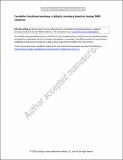| dc.contributor.author | Guell Paradis, Xavier | |
| dc.contributor.author | Schmahmann, Jeremy | |
| dc.date.accessioned | 2020-11-17T22:02:41Z | |
| dc.date.available | 2020-11-17T22:02:41Z | |
| dc.date.issued | 2019-11 | |
| dc.identifier.issn | 1473-4230 | |
| dc.identifier.issn | 1473-4222 | |
| dc.identifier.uri | https://hdl.handle.net/1721.1/128511 | |
| dc.description.abstract | The cerebellum is relevant for virtually all aspects of behavior in health and disease. Cerebellar findings are common across all kinds of neuroimaging studies of brain function and dysfunction. A large and expanding body of literature mapping motor and non-motor functions in the healthy human cerebellar cortex using fMRI has served as a tool for interpreting these findings. For example, results of cerebellar atrophy in Alzheimer’s disease in caudal aspects of Crus I/II and medial lobule IX can be interpreted by consulting a large number of task, resting-state, and gradient-based reports that describe the functional characteristics of these specific aspects of the cerebellar cortex. Here, we provide a concise summary that outlines organizational principles observed consistently across these studies of normal cerebellar organization. This basic framework may be useful for investigators performing or reading experiments that require a functional interpretation of human cerebellar topography. | en_US |
| dc.publisher | Springer US | en_US |
| dc.relation.isversionof | https://doi.org/10.1007/s12311-019-01083-9 | en_US |
| dc.rights | Article is made available in accordance with the publisher's policy and may be subject to US copyright law. Please refer to the publisher's site for terms of use. | en_US |
| dc.source | Springer US | en_US |
| dc.title | Cerebellar Functional Anatomy: a Didactic Summary Based on Human fMRI Evidence | en_US |
| dc.type | Article | en_US |
| dc.identifier.citation | Guell, Xavier and Jeremy Schmahmann. "Cerebellar Functional Anatomy: a Didactic Summary Based on Human fMRI Evidence." Cerebellum 19 (November 2019): 1-5 © 2019 Springer Science Business Media, LLC | en_US |
| dc.contributor.department | Massachusetts Institute of Technology. Department of Brain and Cognitive Sciences | en_US |
| dc.relation.journal | Cerebellum | en_US |
| dc.eprint.version | Author's final manuscript | en_US |
| dc.type.uri | http://purl.org/eprint/type/JournalArticle | en_US |
| eprint.status | http://purl.org/eprint/status/PeerReviewed | en_US |
| dc.date.updated | 2020-09-24T21:45:56Z | |
| dc.language.rfc3066 | en | |
| dc.rights.holder | Springer Science+Business Media, LLC, part of Springer Nature | |
| dspace.embargo.terms | Y | |
| dspace.date.submission | 2020-09-24T21:45:56Z | |
| mit.journal.volume | 19 | en_US |
| mit.license | PUBLISHER_POLICY | |
| mit.metadata.status | Complete | |
